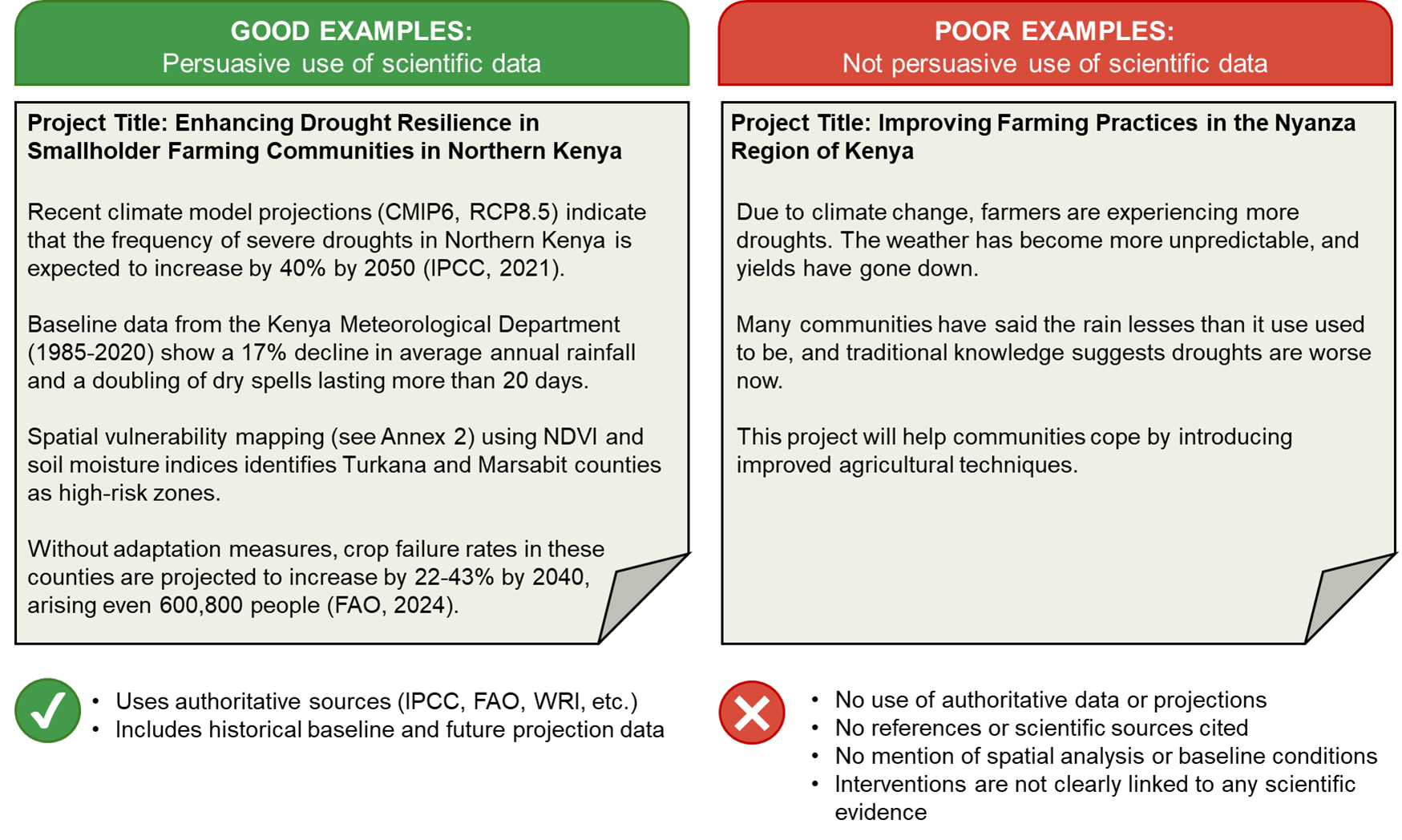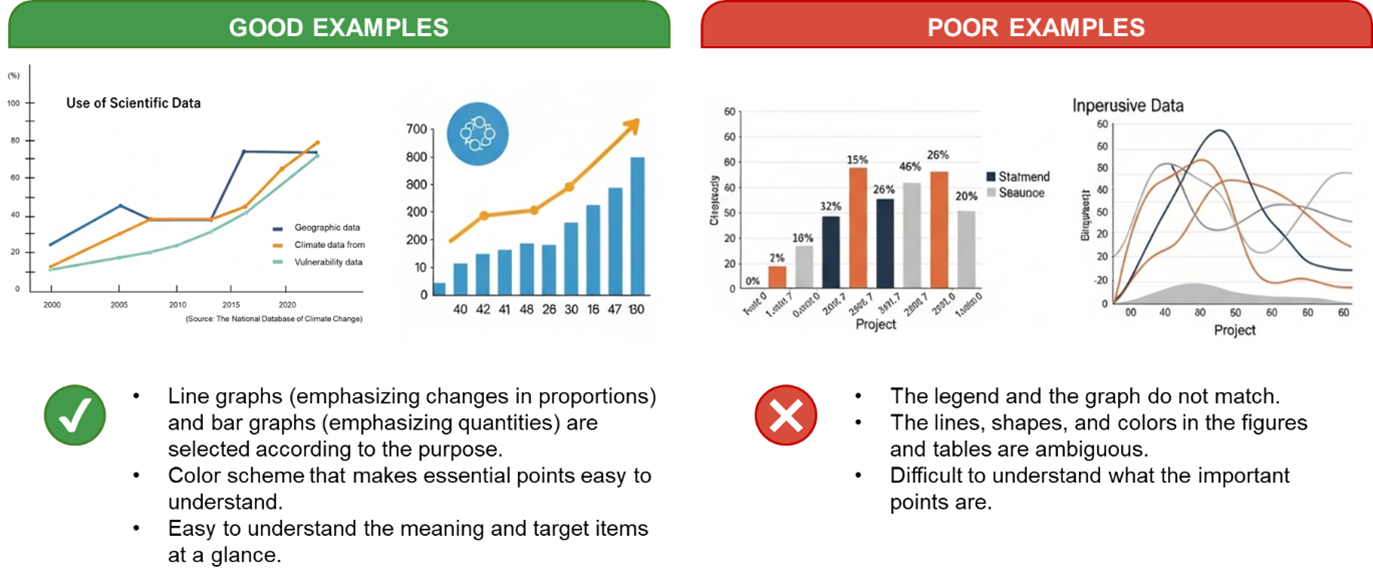A successful Green Climate Fund (GCF) proposal is built on a foundation of strong scientific evidence. To justify the need for climate finance, you must present a clear and compelling “climate rationale”, an evidence-based argument that proves your project is tackling a problem caused directly by climate change. Every Concept Note and funding proposal must demonstrate a clear and scientifically valid climate rationale that justifies the intervention. Insufficient evidence weakens the proposal, as it becomes difficult to determine whether the issue is a climate problem or a general development challenge. Scientific evidence matters because it builds legitimacy, justifies interventions, enables monitoring, and ensures consistency in the argument. To build the rationale, it is recommended to gather diverse scientific data that can represent climate vulnerabilities and risks, socio-economic, and analysis of cost-benefit.
Why Scientific Evidence Matters for GCF
The GCF aims for evidence-based, high-impact, and cost-effective climate solutions. The GCF is mandated to facilitate a "paradigm shift" towards low-carbon, climate-resilient development pathways in developing countries1,2. This core objective dictates that CNs and funding proposals must demonstrate a clear and compelling "climate rationale" and the potential for transformative impact beyond a one-off investment3,4. In the GCF project review process, the clarity and scientific validity of the climate rationale greatly influence whether or not funding is provided. The GCF requirements and application increasingly demand scientifically robust justifications such as baseline data, modeled projections, and spatial mapping. It has been identified that specific mechanisms, such as geospatial data, climate projection tools, and structured vulnerability indicators, are now standard in successful GCF CNs5,6,7. For example, the evaluability review assesses the use of evidence in GCF concept notes and proposals, demonstrating that concept notes and proposals increasingly integrate quantitative data from academic papers, international agency data portals, or national repositories and/or databases to meet GCF investment criteria and support transformative logic7. If the scientific evidence is insufficient, it is difficult to determine whether the issue is caused by climate change, and the concept of climate additionality becomes weak. In addition, how the data is presented is also important. Following figures illustrate both good and poor examples of presenting the obtained data concisely.


Below are the six points taken into consideration when deciding whether to provide financial support to the proposed project. The six evaluation criteria and scientific evidence is also illustrated in the following figure.

- (1)Impact: whether the proposed project has the potential to contribute to achieving the GCF’s objectives and result areas.
- (2)Paradigm shift: whether the activity will have an impact beyond the specific project or investment.
- (3)Sustainable development potential: whether there are broader benefits and priorities.
- (4)Recipient country needs: whether there are vulnerabilities and financial needs of the beneficiary country and its beneficiaries.
- (5)Country ownership: whether the beneficiary country has ownership and the capacity to implement the project.
- (6)Efficiency and effectiveness: whether the target project is economically and financially sound.
Using scientific data is essential to demonstrate the necessity and effectiveness of adaptation projects. By analyzing disaster histories, temperature, and rainfall trends, the climate risks and vulnerabilities of a region can be quantified. This helps justify focusing resources on adaptation measures and provides a solid climate rationale. Future climate projection models, such as RCPs and SSPs, further clarify how risks may evolve, supporting urgent interventions. Scientific baselines allow for clear indicators like KPIs to measure and visualize project results, helping evaluate and present outcomes convincingly. Adaptation strategies involve identifying climate issues, proposing specific countermeasures, ensuring consistency with national policy, and establishing robust monitoring and evaluation systems. Adaptation projects, especially those seeking global funding, must align with international scientific knowledge and major policy documents such as IPCC reports. This enhances global credibility and reliability. Projects consistent with international frameworks are better received by scientific bodies and funding organizations, and are more likely to be adopted. Early incorporation of global scientific evidence in project design greatly improves chances for successful climate change adaptation.
- 1J. Puri et al. (2022) Assessing the likelihood for transformational change at the Green Climate Fund: An analysis using self-reported project data, Climate Risk Management, 35
- 2Schulz, K. et al. (2021) Leveraging blockchain technology for innovative climate finance under the Green Climate Fund, Earth System Governance, 7.
- 3Barnes, J. (2025) The Expert Epistemology of Climate Finance: Re-Visiting the Depoliticisation Critique, Antipode. https://doi.org/10.1111/anti.70002.
- 4Jonas Bertilsson (2023) Managing vulnerability in the Green Climate Fund, Climate and Development, 15:4, 304-311, DOI: 10.1080/17565529.2022.2081118.
- 5Torterat, Laurene, and Galyna Uvarova (2022). Introducing geospatial footprint of the GCF's portfolio: Project location geocoding methodology. Working paper No. 6 (September). Songdo, South Korea: Independent Evaluation Unit, Green Climate Fund.
- 6Rosenstock, T.S.; Joshi, N.; Steward, P.R.; Kristal, J. (2024) Data utilized in African Green Climate Fund Agricultural Adaptation Projects and its availability in selected Decision Support Tools (DSTs). https://doi.org/10.7910/DVN/PY3YOZ.
- 7Fiala, Nathan, and others (2022). Evaluability assessment of the Green Climate Fund funding proposals. IEU learning paper (December). Songdo, South Korea: Independent Evaluation Unit, Green Climate Fund.
Types of Scientific Data Required
A practical GCF concept note necessitates diverse scientific data to substantiate its claims and demonstrate impact. Below are the various types of scientific data required in the GCF concept notes and proposals.
Climate Vulnerability and Risk Assessments:
- Historical Climate Data: This includes localized data on temperature trends, precipitation patterns (e.g., standardized precipitation index, dry spell trends), and the frequency and intensity of extreme weather events like droughts, floods, tropical cyclones, and storms.
- Climate Projections: Future climate scenarios, such as projected temperature increases, rainfall changes, or sea-level rise, are crucial for demonstrating future risks.
- Vulnerability Components: Data broken down into exposure (geographic location, direct climate impact), sensitivity (population density, ecosystem degradation, poverty, food insecurity), and adaptive capacity (literacy rates, access to markets, institutional strength, and technological access).
- Sector-Specific Data: For agriculture, this might include data on crop yields, soil conditions, water availability, and agro-ecological parameters.
- Qualitative Data: While quantitative data is prioritized, qualitative descriptions of vulnerability are accepted, especially when direct quantitative data is scarce. The GCF encourages considering alternative systems of knowledge, including traditional knowledge.
Socio-economic Data:
- Population Data: Demographic information, including breakdowns by gender, age (youth), and indigenous status, highlighting vulnerable groups.
- Economic Indicators: Data on income levels, poverty rates, and broader economic metrics like GDP, which can inform "ability to pay" considerations for funding.
- Livelihood Information: Details on existing livelihoods and how they are impacted by climate change.
Cost-Benefit Analysis Data:
- Financial and Economic Viability: Data supporting the financial sustainability and economic returns of proposed interventions, including a cost-benefit analysis (CBA, discussed in separate chapter).
- Carbon Co-benefits: Monetized values of associated carbon benefits.
- Cost-Effectiveness: Metrics such as marginal abatement cost for mitigation projects or cost per beneficiary for adaptation projects, demonstrating efficient use of funds.
- Concessionality Justification: Data that clearly justifies the need for GCF grants or concessional loans, particularly for public goods, technical assistance, or de-risking private investments.

